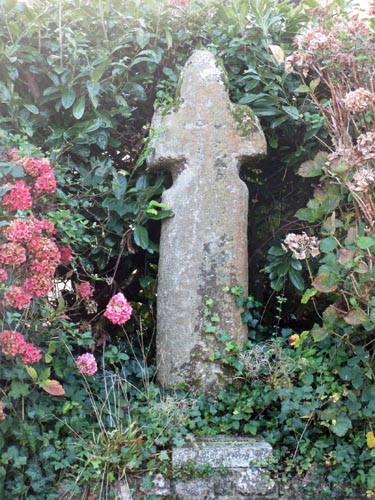 Location:
The cross stands on top of the roadside wall of a thatched cottage called
‘Wrangaton’, at the corner of a junction on the road from South Brent
to Bittaford. Location:
The cross stands on top of the roadside wall of a thatched cottage called
‘Wrangaton’, at the corner of a junction on the road from South Brent
to Bittaford.
O/S Grid Ref: SX/67676/57889 Longitude/Latitude (Degrees+/-): -3.86346/50.40593 Map location: Click here to view map. Purpose: Waymarker. Size: 5 feet 2 inches (1.58 metres) tall. 1 foot 7 inches (0.48 metres) across the arms. The shaft is 15 inches (0.38 metres) wide. The incised cross, on the roadside face, measures 10 inches (0.25 metres) high and 10 inches (0.25 metres) across the arms. Information:
This unusually shaped cross has been
fashioned from a substantial block of granite. The shaft is oval in section,
tapers slightly towards The cross now stands in a modern rectangular socket stone, on the face of which is a plaque, which reads: VICTOR LOBB OF WRANGATON 1905 - 1977. Mr Masson Phillips recorded that the cross was found at a nearby crossroads, being used as a gatepost. Thankfully, it was rescued and by 1937 it was standing in the middle of the lawn in the garden of Wrangaton House. In 1959 it was removed from the lawn and erected in its current position for all passers-by to enjoy. No records can be found of its origins but, judging by its size, it would have been an important monument and is unlikely to have been moved far from its original site.
|